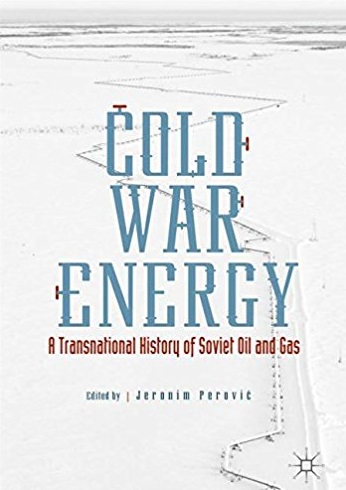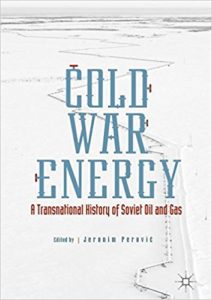

This is part of our special feature, Diversity, Security, Mobility: Challenges for Eastern Europe.
Even amid a recently growing body of energy histories, there has remained a dearth of studies investigating the Soviet Union as a primary protagonist rather than a mere rival to western Cold War pursuits. As Cold War Energy makes clear, however, this trend derives less from a lack of interest than from an only recently and partially overcome lack of sources. This volume – the outgrowth of a 2015 conference in Zurich – takes major strides to fill this historiographical gap. In doing so, it offers a necessary counter to common presuppositions about East-West relations and the ability of a given administration to force other governments and even powerful national sectoral interest into compliance. Soviet oil and gas policy, in other words, was multi-faceted, adaptive, and, quite often, contended. It responded not just to ideological considerations, but also domestic interests, geopolitical developments, and changing market conditions.
The volume opens with an introduction by editor Jeronim Perović that makes a strong case for the importance of this volume. The histories of global and even Soviet petroleum tend to be written by the western victors (a superlative contended in the final chapter) based too exclusively on traditional narratives of Cold War conflict. This has created blind spots. As Perović argues, intra-bloc cooperation must be considered alongside East-West confrontation. Indeed, although the Soviets sought to establish a hegemonic “energy space” in Eastern Europe, they also actively traded with the West for the very technology and currency necessary for furthering their own petro-development projects (particularly in Siberia) and “compensat(ing) for the losses” accrued in maintaining heavily subsidized energy flows to the Council for Mutual Economic Assistance (CMEA). Soviet energy policy created burdens as well as opportunities, divisions as well as bridges, enduring routes of energy flows as well as conflicts of interest.
The first of three sections in Cold War Energy addresses the transitional period between the Second World War and the Cold War. The first chapter, “From Crisis to Plenty,” traces the changing role of petroleum in the Soviet Union’s energy economy under Stalin. Here, Felix Rehschuh emphasizes the disjuncture between the Soviet Union’s access to the fields of Baku – the largest in Europe – and Stalin’s apparent indifference to petroleum’s potential for industrialization. Oil was initially seen as a commodity to trade for much needed foreign currency and industrial materials. Instead of petroleum, the Soviets focused domestic energy policy on coal liquefaction through German-pioneered techniques adopted most fervently in the Nazi pursuit of energy autarky. This was, Rehschuh points out, a peculiar policy for the Soviets given the massive reserves in Baku as well as the recently discovered “Second Baku” in the Volga-Urals. Indeed, as Rehschuh states unequivocally, “the oil-rich Soviet Union would have been better off pursuing conventional investments in oil extraction” than in coal processing and “constantly changing investment allocation decisions” that focused on refining for export over exploration and production (52-3). It was only with the German invasion in 1941 and that the domestic importance of oil was realized.
The next chapter, written by Nataliia Egorova, addresses the energy dimensions of the Iranian Crisis of 1945-6. Careful to emphasize the importance of the crisis itself, Egorova argues that it should not be considered the spark to the Cold War. Although the Soviet Union and United States were critical actors, possibilities and even a desire for cooperation among the emerging East-West blocs still existed. This point is well taken. This reviewer, however, wonders whether the distinction between “the beginning of the Cold War” and a “significant contribution to the birth of the postwar confrontation” (82) is under-examined. Much more compelling is Egorova’s argument that the lingering Soviet military presence in Iranian Azerbaijan was not about territory or even political dominance (though political influence remained a factory), but more immediately about oil concessions and stemming American and British influence. Whether a proto- or early Cold War bout, it speaks directly to the centrality of resource access to that nascent conflict.
Niklas Jensen-Eriksen’s contribution, “’Red Oil’ and Western Reactions,” focuses on British responses to the Soviet reentry into world markets at the turn of the 1960s. Contrary to conventional understandings, Jensen-Eriksen argues that the 1959 British embargo of Soviet petroleum was highly contentious in key circles of the British government. Whereas the politically-minded Foreign Office and the Ministry of Power – inclined to support the interests of the oil companies – opposed importing “red oil” out of fear of its disruptive effects on the British oil market and growing dependency on a geopolitical enemy, the Board of Trade – in support of oil consuming industries – and the Treasury were publicly neutral on the topic but privately welcomed the opportunity to purchase cheap Soviet petroleum. Such intra-governmental and inter-industry disagreement gave the Soviets the opportunity to exploit contending interests and undermine the boycott over the subsequent several years.
Red oil, of course, provoked contention far beyond England. As Roberto Cantoni shows in the final chapter of this section, the Soviet “oil offensive” of the early 1960s sewed rifts among NATO and European Economic Community (EEC) allies as well. Unsurprisingly, many arguments in these bodies echoed those of the British case. The Americans and British emphasized the threat of overdependency on eastern sources and Soviet economic growth. The French, Italians, and, to an extent, West Germans, however, focused on the promise of opening western markets to cheap and abundant eastern feedstocks in exchange for the hard currency that would, in turn, open the Soviet Union to western exports. Trade, of course, is not merely an abstract spreadsheet of numbers but the actual circulation of goods. Pipelines, therefore, played a central role in these discussions. NATO, the defensive organization, opposed western participation in Soviet pipeline construction on political grounds; the EEC promoted it with economic rationale. Ultimately, not only arguments for and against a pipeline embargo, but also appraisals of the industrial value, economic impact, and, even, definition of large-diameter petroleum pipelines broke down along similar lines. By the end of 1962, the Anglo-American argument won out and a western embargo was imposed to notably weak results.
Part II of this volume is dedicated to the period of East-West détente. Viacheslav Nekrasov’s contribution bridges the Cantoni chapter and the largely Brezhnev-focused chapters that follow with an investigation the oil policies of Nikita Khrushchev. Using recently published transcripts of Party Congress and Central Committee meetings among numerous recently declassified and unpublished archival sources, Nekrasov depicts a stark contrast between the coal-industrial policies of Stalin and the hydrocarbon development objectives of Khrushchev. Indeed, it was an ideologically and economically-informed focus on chemical rather than raw material exports that drove Khrushchev to direct resources away from pipeline projects heavily dependent on western imports toward the intensive development of domestic downstream production capabilities. These efforts, however, faltered in the face a deficit in specialized knowledge, an abundance of “incompetence and opportunism,” and active resistance from various industrial companies, lobbies, and even Gosplan, the state planning committee.
Elisabetta Bini’s chapter focuses on the contending policies of the United States and Italy – and primarily the state company ENI towards the Soviet Union. Using materials gathered primarily in the United States and Italy, Bini posits that ENI and the Italian government more broadly seized on American-Soviet tensions to simultaneously acquire fuel and feedstocks for Italian markets and to carve out a larger space for ENI and Italy in western and world affairs. Interestingly, Bini goes on to argue quite convincingly that Italy pioneered and facilitated relations East-West – both infrastructural and political – that Western Europe would adopt by the early 1970s, simultaneously promoting greater dependence on Soviet hydrocarbons while deepening East-West infrastructural integration.
The following chapter by Alain Beltran and Jean-Pierre Williot similarly examines East-West company-country relations by exploring the French Gaz de France’s (GDF) quest for Soviet natural gas. Having access to Algerian gas in the early 1960s, GDF started to seriously consider Soviet gas only in 1966. By 1971, France and the Soviet Union would sign the first of several treaties exchanging French equipment and pipelines for future gas deliveries to GDF starting in 1976. Conveying the gas to France, however, would involve constructing a pipeline that would cut through Czechoslovakia, Austria, and Germany before terminating in France. A key element of infrastructural integration and energy interdependency, this pivot frustrated American attempts to pull Europe into a more restrictively western energy trade bloc. It also, however, exploited the Soviet Union’s own energy-economic weaknesses. Although gas flowed from East to West, the materials, technologies, and currencies conveyed in the opposite direction ensured an interdependency, wherein the Soviet Union was at least as reliant on the Western Europeans as they were on Soviet hydrocarbons.
Similar concerns weighed on the Federal Republic. Dunja Krempin’s contribution traces the evolution of German-Soviet energy relations during the 1970s, a critical period of transition wherein West Germany energy sector began to diversify its energy sources. Rather than focusing just on trade, however, Krempin also examines the reflexive effects of the growth in East-West trade. In the end, she makes a strong case that the growing West German and European thirst for Soviet gas not only contributed to the tentative stability of détente, but also grew the infrastructure and western markets that ultimately enabled the development of Western Siberia, thereby encouraging even deeper cooperation.
David S. Painter’s contribution closes section two with a compelling refutation of the “Reagan Victory School” appraisal of the Soviet collapse. Although he acknowledges that the Soviet Union needed American technologies and trade that the Reagan administration tactically withheld, Painter also analyzes the role Western Europe played in providing these very same resources and largely neutralizing the effects of American isolation policy. Even the 1985 Saudi increase in production that was so crucial to the global decline in oil prices was primarily a Saudi initiative taken in the interest of Saudi exports. The end of the Soviet Union, in other words, was more an admixture of Tsarist-rooted “economic backwardness,” population centers far removed from oil and gas sources, “the inherent contradictions of the Soviet system,” and fluctuations in global oil prices than of Reagan-era pressures.
The third section of this volume addresses similar questions of Soviet decline and collapse. Falk Flade’s “Creating a Common Energy Space” focuses on the Druzhba (Friendship) Pipeline and argues that the pipeline encouraged not just the Eastern Bloc’s dependency Soviet gas but also political stability within satellite states. The pipeline, moreover, almost immediately became a burden to a Soviet energy economy that was dependent on western markets and technologies, but constrained by obligations to Eastern Europe. Although Moscow remained the hegemon, such onerous obligations likewise gave the CMEA countries considerable bargaining power when the Soviet Union threatened to redirect flows to the West.
This interdependent relationship, Suvi Kansikas argues in her chapter, came under stress when the global oil price drop of the 1980s caused the Soviet leadership to reconsider the preferential position to which it had elevated Eastern European political stability over national economic concerns. Kansikas offers some compelling insights into the complexity of intra- and inter-bloc trade, particularly concerning the simultaneous liberalization of trade within the Western European Community and the selective protectionist barriers erected around it. This system favored trade with the Soviet Union over Eastern Europe, denying the latter the foreign currency necessary to pay the latter and convincing Moscow to redirect energy flows to the more lucrative western markets.
Lorenz M. Lüthi’s chapter addresses similar questions through examining declassified East German material concerning “CMEA meetings, internal assessments, and conversations between Soviet and East German officials.” Through this, he analyzes the tensions within the CMEA over oil and gas supplies, pipelines, and electrification. Such tensions existed not only between the International Investment Bank (IIB) – the Soviet counterpart to the International Monetary Fund – and the Eastern Bloc, but among bloc members who had varying national economic and energy needs, trade strategies, and credit ratings. Given the welter of conflicting interests, Lüthi argues, energy integration simultaneously facilitated and eroded “Soviet economic imperialism” over the bloc, particularly during the recession of the 1980s.
The final chapter traces the legacies CMEA energy relations examined above into the present day. As previous studies complicated simplistic visions of Soviet energy dominance, Margarita M. Balmaceda convincingly argues that post-Soviet energy, political, and economic connections still “go well beyond energy dependence” (401) of the Eastern European periphery on the Russian core. Interestingly, Ukraine is one of her three primary cases. (Belarus and Lithuania are the other two.) Ukraine inherited some of largest gas storage facilities and sophisticated refinery systems in the former Soviet sphere, ensuring it would continue to be utterly dependent on Russia for much of its energy consumption even after political independence. Reciprocally, post-Soviet Russia continues to rely on this same Ukrainian infrastructure for exports to Europe. Balmaceda makes clear that such interdependency is to the greater detriment of Ukraine than Russia. Still, the fact that she introduces the reverse – Russia’s dependency on Ukraine – begged this reader’s interest in the other side of this interdependency. If we can truly speak of bidirectional power relations, there must be more to Ukraine’s ability to restrain Russia’s ability to manipulate flows through the country. Still, Balmaceda’s larger argument is quite cogent. Pipelines and long-term energy flows may generate dependencies, but they are also “modifiable.” They are legacies, she argues, not destiny.
This volume is quite impressive. It covers much new territory, effectively utilizes previously inaccessible materials, and offers nuanced insights into Soviet and CMEA energy policies during the Cold War. Themes of transnationalism, infrastructure, East-West connections, and energy provide common points of reference among chapters and create a coherent and topical collection. Several contributors, for instance, emphasize that, despite western fears, the Soviet Union never deployed its oil and gas weapon to gain political concessions from the West or its eastern allies. Such potential, as addressed most directly by Balmaceda, was only realized in the Russian Federation, who nevertheless was and still is alternately enabled and constrained by the legacies of Soviet energy policy. The collapse of the CMEA fractured the Soviet empire geopolitically, yet it severed neither the pipelines nor other physical infrastructure and networks of energy exchange erected since the Second World War. To gain any understanding of the current situations in Ukraine, Russia, the former Eastern and even Western Europe, therefore, one needs to view them in part as a legacy of Cold War energy politics and in part through a Soviet lens. For these reasons, this book comes at an eminently fitting time.
Reviewed by Nicholas Ostrum, Clark State Community College
Cold War Energy: A Transnational History of Soviet Oil and Gas
Edited by Jeronim Perović
Publisher: Palgrave Macmillan
Hardcover/425 pages/2017
ISBN: 9783319495316
To read more book reviews, please click here.
Published on December 6, 2017.




